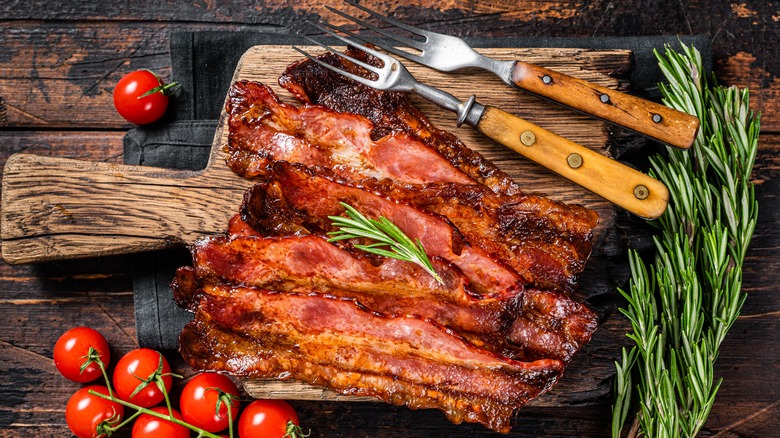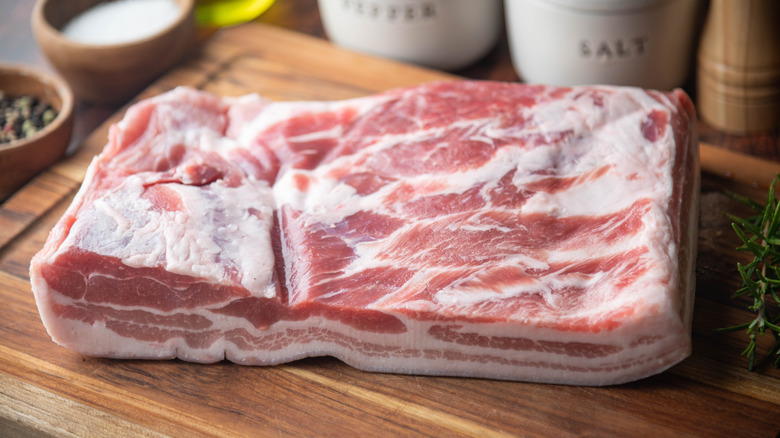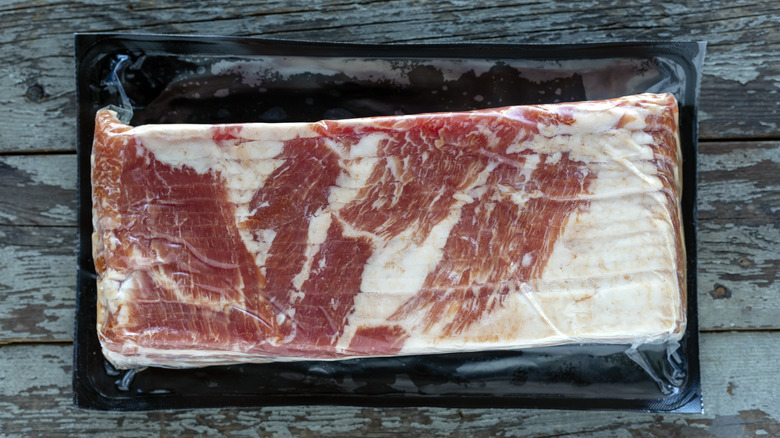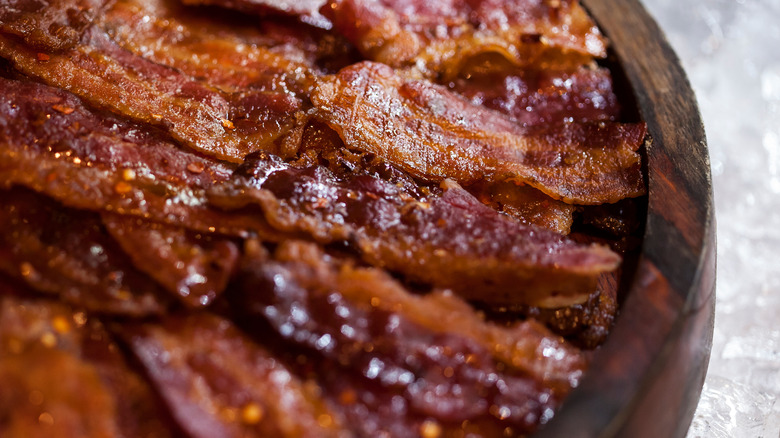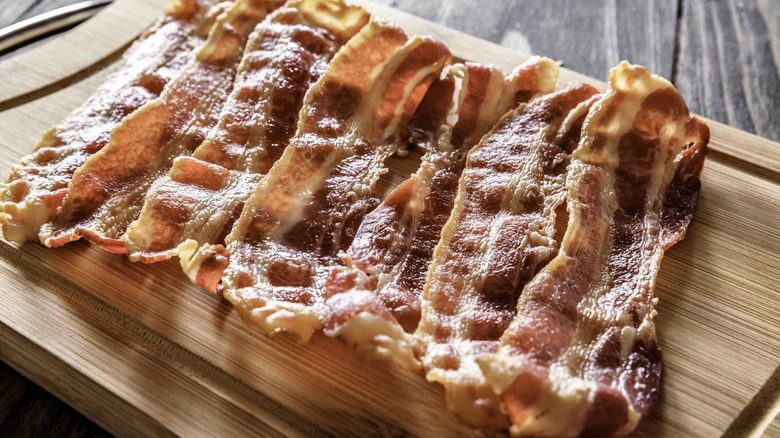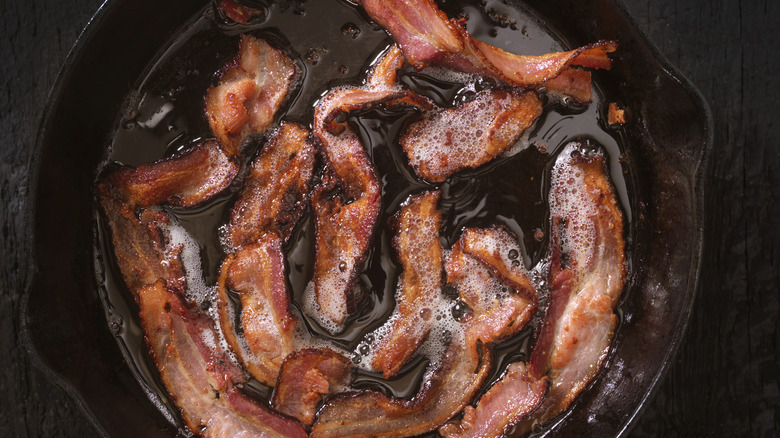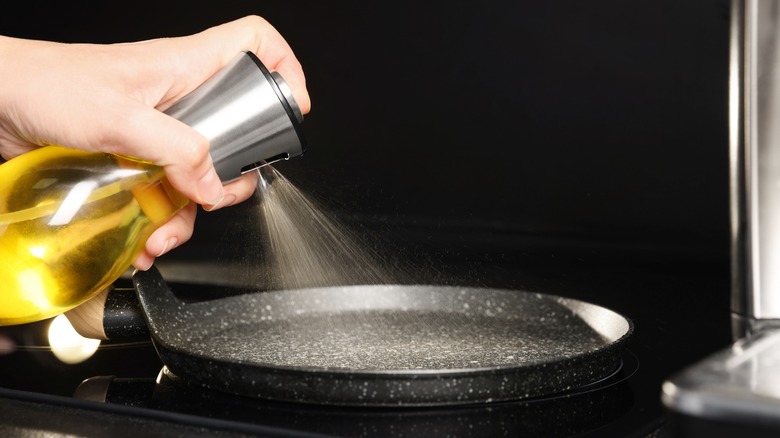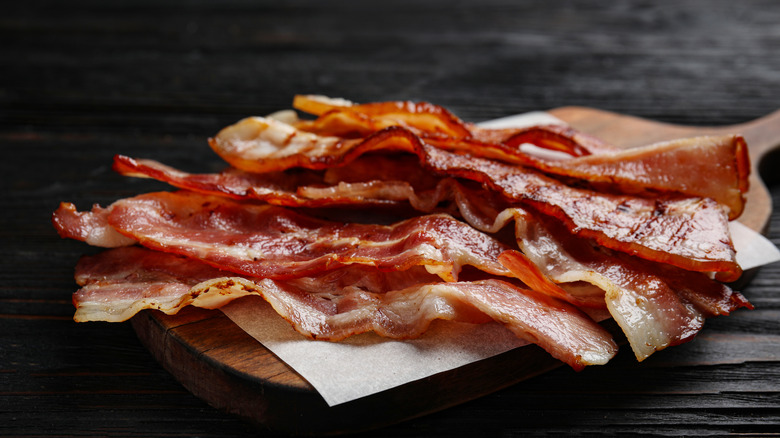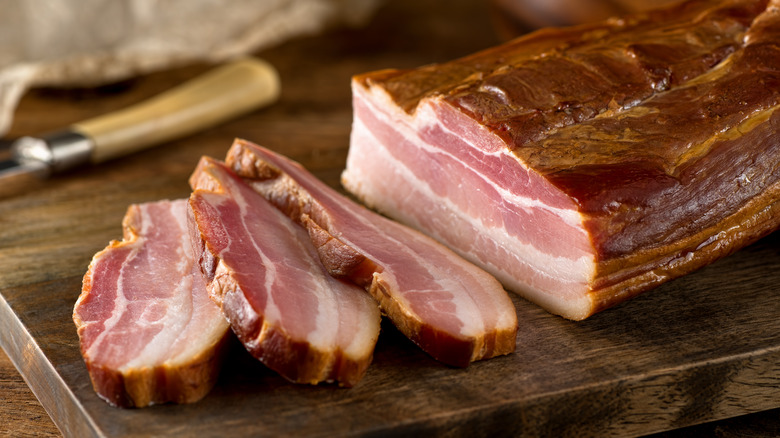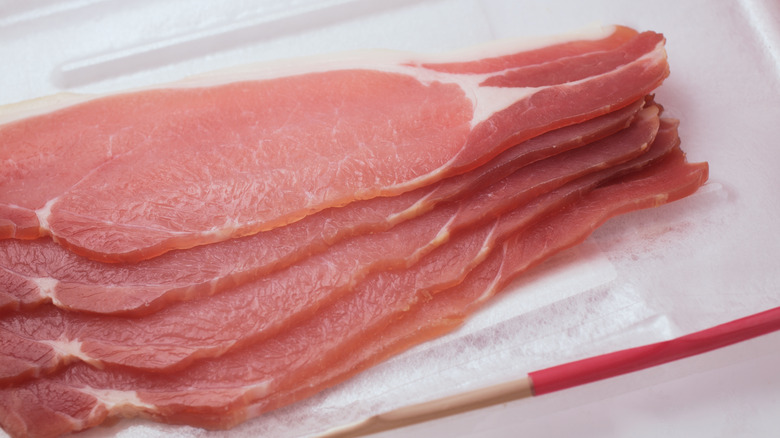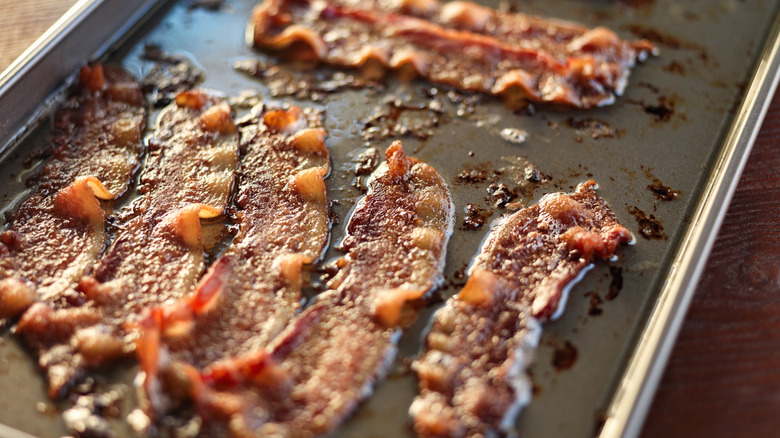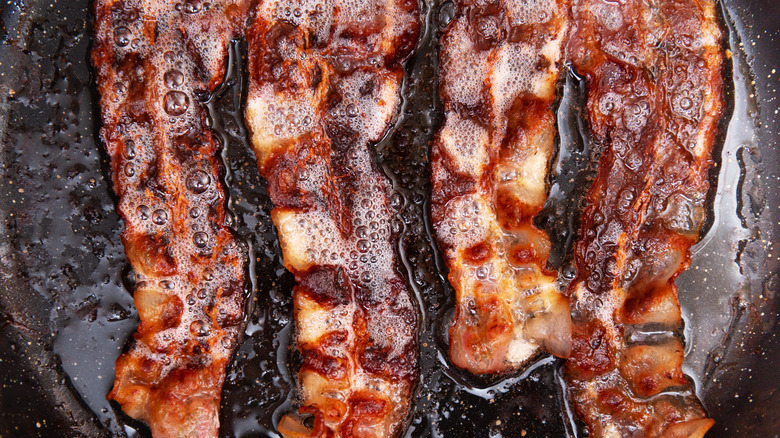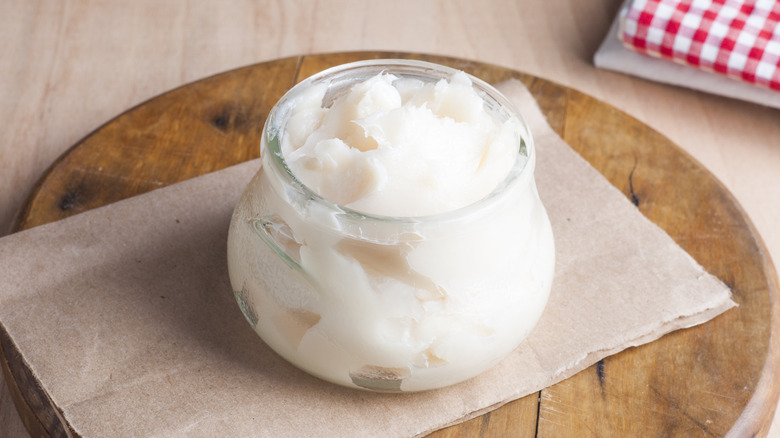Bacon Rules You Should Never Break
Bacon can be found in countless recipes, and what was once a slice of simple meat enjoyed on its own now finds its way into burgers, brownies, and even jam. But amidst all this, you should never forget about the joy of bacon on its own. Bacon's complex taste comes from its lengthy production process, which starts with the belly of pigs reared on a varied, nutritious diet.
The pork belly is then brined and smoked, with the types of wood used, including apple, hickory, or maple, each of them giving the meat its own unique flavor. Finally, the belly is sliced into bacon pieces, which inevitably end up in our skillets, and then on our plates.
When bacon is made well, all these stages are performed with love, care, and attention. And this makes getting it right in the kitchen even more important so that you don't end up ruining a quality product with poor technique. But cooking bacon, like anything else, is a process, and there are certain rules that you should follow to the letter to get the best from your meat.
Look for the perfect fat ratio
The key rule for flavorful, juicy bacon is to make sure you're nailing your amount of fat to meat. The fat in bacon allows it to stay well-lubricated and moist and gives a richness of flavor that other meats just can't replicate. Too little fat and your bacon can end up dry and brittle; too much, and it can end up greasy and slimy.
In the ideal bacon slice, you're looking for a roughly even split, with potentially a little bit more fat than meat, depending on your taste. A 60/40 ratio of fat to meat is the maximum you want to go for, as anything higher than that will start to impact the taste and texture of your bacon.
Remember that while bacon gives you a handy indicator of its fat content via the white strips on its meat, in commercial packaging, it can be difficult to tell just how much there is. Typically, slices are often layered on top of each other, hiding the true ratio. Instead of being fooled, simply check the nutritional information of the product on the back — if the slices have equal amounts of fat and meat, you're on to a winner.
Don't keep it for too long before cooking
Bacon can feel like one of those meat products that last forever. This is, perhaps, because people assume that the curing and smoking process preserves it in some way, giving it a similar quality to dry salami or cooked chorizo. But bacon, as raw meat, is entirely perishable, and leaving it too long may result in your meat spoiling and potentially becoming unsafe to eat.
So don't leave your bacon chilling out too long: Cook it quickly. If you haven't opened your bacon yet, you have a fairly generous window of time before it goes off, with roughly two weeks until it spoils. Opened, raw bacon will spoil faster, thanks to the meat's contact with oxygen, contributing to microbe growth. You will have up to a week to use your bacon if you've already opened it, although that isn't a totally hard-and-fast rule.
If you notice that your bacon changes color, feels sticky to the touch, or smells sour or rancid, throw it out. The most important thing to do is to follow the "use-by" date instruction on the back of your pack to the letter, or if you're buying it from a butcher, ask them when you should cook it by.
Use additions that will amp its natural flavors
Bacon is pretty great on its own. But if you're not making some changes to it to make it even better, you're frankly missing out. Bacon is full of sweet, smoky, and peppery tastes, thanks to its curing and smoking process, and while these can shine on their own, a few additional ingredients can highlight these flavors and make the meat even more intense and satisfying.
A simple, quick way to do this is by making candied bacon, as celebrity chef Alex Guarnaschelli likes to do. Mix together some cracked black pepper and brown sugar, and then lay your bacon slices in the combination, dredging them on each side. Then, cook them by putting them in the oven and baking until crispy and golden.
The sugar will caramelize, aided by the fat rendering from the bacon pieces, with the black pepper providing a bold flavor contrast. The beauty of using this method is that bringing out each individual flavor with more intensity actually makes the bacon more versatile, meaning it becomes even better for use in sweet dishes as well as savory.
Smoked and unsmoked bacon have different uses
One key thing to remember about bacon is that it's not made the same way every time, and you should be rigorous about which type you use for which recipe. Bacon generally falls into two categories, smoked — which is the most common — and unsmoked.
Smoked bacon, as you might expect, undergoes a smoking process, which is either done by smoking the meat with heavily-scented wood chips or by injecting the meat with liquid smoke and placing it in an oven. This gives the meat a way more intense flavor and, naturally, a smokiness. Unsmoked bacon bypasses this step but still has a salty, developed flavor thanks to being cured in a mixture of sugar, salt, spices, and preservatives.
It's important not to use one type of bacon where the other would be better, as doing so may either underpower or overpower your dish. For bacon that you're enjoying on its own, for example, we'd recommend using the smoked variety. As smoking adds extra layers of flavor, you get to enjoy all of them when the bacon's taste isn't being distracted by other things.
On the other hand, in situations where the bacon serves to add salt and fat as its primary flavor notes, it's better to go for unsmoked. Unsmoked is also the better choice if you're using it in recipes that have other smoked elements, such as stews containing kielbasa or andouille.
Use the rule of three, says Guy Fieri
The "rule of three" is something that's well-known to writers and storytellers, with the idea being that things become more satisfying and easy to understand when they come in trios. But it's a little-known fact that it's a rule that can also apply to bacon.
Well, according to Guy Fieri, that is. The "Diners, Drive-Ins and Dives" host laid out his ethos on bacon via Instagram, with a picture of him cooking bacon on a griddle. The post is accompanied by the caption, "When cookin' bacon, count out [three] pieces for each person... then triple it." We can get behind that.
While we might approve of Fieri's rule on a pure satisfaction level, on a nutritional level, it may not be entirely sound. A single slice of medium bacon contains approximately 43 calories, just over a gram of saturated fat, and 185 milligrams of sodium. It's that last number that could cause some concern. Eating nine slices of bacon, as Fieri suggests, could see you consuming around 1,665 milligrams of sodium — that's well over half of your daily recommended value.
Bacon should always be cooked in one go
"Mise en place" is a key practice for chefs around the world, in which people working in kitchens ensure their food is prepared as it can be before they do the final cooking process, saving time in a busy kitchen. In some kitchens, this can extend to partly-cooking ingredients, like parboiling potatoes or blanching vegetables. But when it comes to bacon, it should never be cooked in two sittings and only ever in one shot.
When you partly cook bacon, you may not heat it up to an internal temperature where any potential bacteria inside are killed, according to the USDA. You may not also subsequently do so if you're finishing it off later on, meaning that you still leave yourself and anyone you're feeding vulnerable to foodborne illness.
According to Healthline and the CDC, bacon can host a number of microbes that cause illness, including Salmonella and infection from roundworms or tapeworms. Always ensure that you're cooking the meat through entirely before serving it. The USDA also reported that it's entirely fine to reheat fully-cooked bacon, but just make sure you're heating it through fully so that you limit the risk of foodborne bacteria that's taken residence after the meat was cooked.
You should always begin with a cold pan
Cooking bacon the right way may not seem like a challenge. You just throw it in a pan, heat it up, and pull it out when it's crispy, right? Unfortunately, that's not the case. Bacon can be surprisingly reactive to the heat of your pan when you're beginning to cook it, and if your skillet is too hot, the fat will seal too quickly. This results in it being unable to render effectively, which is a key step in getting crispy bacon, and it will remain chewy and hard to eat.
Adding bacon to a hot pan can also cause it to shrivel up and lose its shape quickly, creating the further issue of potentially scorching the meat, resulting in an uneven result. Instead, the key rule you should follow is to add your bacon to a cold pan and then heat the pan up with the bacon simultaneously.
By doing this, the fat is able to gently come to temperature, and in doing so, it will be drawn out into the pan more slowly, leaving crispy slices. This technique also allows you to control the cooking rate of your bacon more effectively.
Never leave cooked bacon out for too long
If you're cooking a large meal, getting the bacon out of the way first before you focus on the other components can seem wise. But doing this can leave your food susceptible to harmful bacteria. Once you've finished cooking food, it will immediately begin to drop in temperature, quickly coming down into what's known as the "danger zone." This is the temperature range that provides the ideal habitat for bacteria like E. coli and Salmonella to grow and multiply.
The danger zone is between 40 to 140 degrees Fahrenheit; in certain conditions, bacteria can duplicate in number in 20 minutes when food is sitting at this temperature. While you can leave food out for a short amount of time, anything that's been sitting out for over 2 hours will begin to be unsafe, and your cooked bacon should be eaten or put in the fridge.
This period might be even shorter — as small as an hour — if it's an especially warm day or if your kitchen is particularly hot. If you are making your bacon ahead of time and refrigerating it, though, make sure that you let it cool properly before putting it in. Placing warm food in the fridge can produce condensation and raise the overall interior temperature of the machine.
Starting with the best product is the most important thing
No matter how you cook your bacon, you won't get a good result unless it's great meat. Bacon is available at a range of price points, and while it's not strictly true that cheaper packs will be worse, they're far more likely to come from animals that have been factory farmed.
Buying factory-farmed meat may pose certain moral questions due to the treatment of the animals in these facilities. It's also the case that bacon from confined animals may be less nutritious and have a poorer fat-to-meat ratio. As well as this, factory-farmed meat is also perceived to taste worse, according to a study published in PLOS One, as people tend to associate poorer conditions with poorer flavors.
For all of these reasons, opting for the best bacon you can afford is an unbreakable rule. We suggest doing some research into the brand you're considering and trying to seek out producers that treat their animals and workers humanely.
It may also be best to avoid bacon brands that use artificial ingredients or add hormones to their products. Appearance-wise, you should look for bacon that has long, consistent veins of meat, with a rosy pink hue, and slices that aren't overly fatty. Crucially, too, make sure that your bacon has been stored correctly in the supermarket. Avoid any packs that feel warm to the touch, and pick products that are well within their use-by date.
Always cook bacon at room temperature
The starting point of your bacon will significantly affect how it turns out. It's easy to forget sometimes that fridges are chilled to near-freezing temperatures, and cooking meat from that cold of a point can cause it to cook unevenly.
When cold meat hits a hot pan, the muscle fibers in it tighten immediately, and this can make it difficult to cook through evenly. This may be particularly problematic for thick-cut bacon, which needs longer in the pan to cook through properly, and this can leave you with bacon that's burnt on the outside and underdone in the middle.
Bacon is also tricky to cook when cold because of its high-fat content. Fat and meat warm up at different rates, with fat lagging behind and taking longer. Therefore, if you're taking a cold piece of meat from the fridge and putting it directly in the pan, your meat will cook before your fat does, again resulting in an uneven end product.
The solution, though, is just to plan ahead slightly. Take your meat out of the fridge 15 minutes before you cook it. This will give it enough time to warm up. To speed things up even more, separate the slices, placing them on a plate.
When cooking bacon in the oven, always stick to the same heat
Cooking bacon in the oven has certain advantages over frying it in your skillet. You don't have to worry about fat splattering all over your stovetop, there's altogether less labor involved thanks to not having to flip it endlessly, and the enveloping heat means it cooks consistently from all angles.
All of these things, though, are contingent on using the right temperature. If you set it too high, the bacon will overcook in parts while staying undercooked through its middle. On the other hand, setting your temperature too low will mean you're in for a long wait.
Ideally, you should aim for a temperature between 350 to 425 degrees Fahrenheit for the best results. Your bacon package may indicate what's best for that specific product and the thickness of the meat.
Once you've picked your temperature, try to avoid changing it unless it looks like your meat is burning or taking too long. And as with pan-frying bacon, you can start with a cold oven and let it heat up with your bacon. Doing so may help the fat to render off more effectively, which is key to getting the best crunch.
Never overcrowd your bacon
Bacon needs a bit of space at times. And this is never truer than when it's cooking. If you cook too many slices of bacon at once, the heat from the pan cannot escape properly, instead getting trapped and forming steam. This steam then changes into water, which essentially then simmers the bacon instead of frying it.
A further problem is created by the fact that bacon can have water added to its meat, which can occur during the brining process, and which also has the effect of making the bacon seem plumper and bigger. But when it comes into contact with a hot pan, this water can then leak out, and if there's too much bacon in there, the water has nowhere to go.
The key is to be sparing with the amount of bacon you put in the pan at any time. If you give the slices enough space, the released water will evaporate properly. Your bacon will then be able to crisp up instead of remaining water-logged.
Always save your bacon grease
Bacon can release a lot of fat when cooked, and it's difficult to know what to do with it. Disposing of bacon grease can also pose problems. When it's hot, it remains in liquid form, but when it gets colder, it turns into a solid, fatty lump. This can not only be unpleasant to dispose of, but if you've resorted to pouring it down the sink, it could clog up your drains.
But the truth is that you shouldn't be throwing away your bacon grease at all — you should be saving it. Bacon grease has an intense flavor that boosts your dishes in a similar way to goose fat or butter but adds saltiness and richness all of its own. Reusing the fat released from the bacon also helps to cut down on food waste.
To save it, all you have to do is allow the bacon grease to cool in the pan until it's warm to the touch. Then, pour it into a heatproof jar or container, and allow it to cool completely before putting it in the fridge. You can also allow it to cool fully in the pan before using a rubber spatula to scrape it off and into your container of choice. In your refrigerator, bacon grease will last for up to three months before it goes rancid. Use it as you would any other fat, heating it first before adding it to your food.
